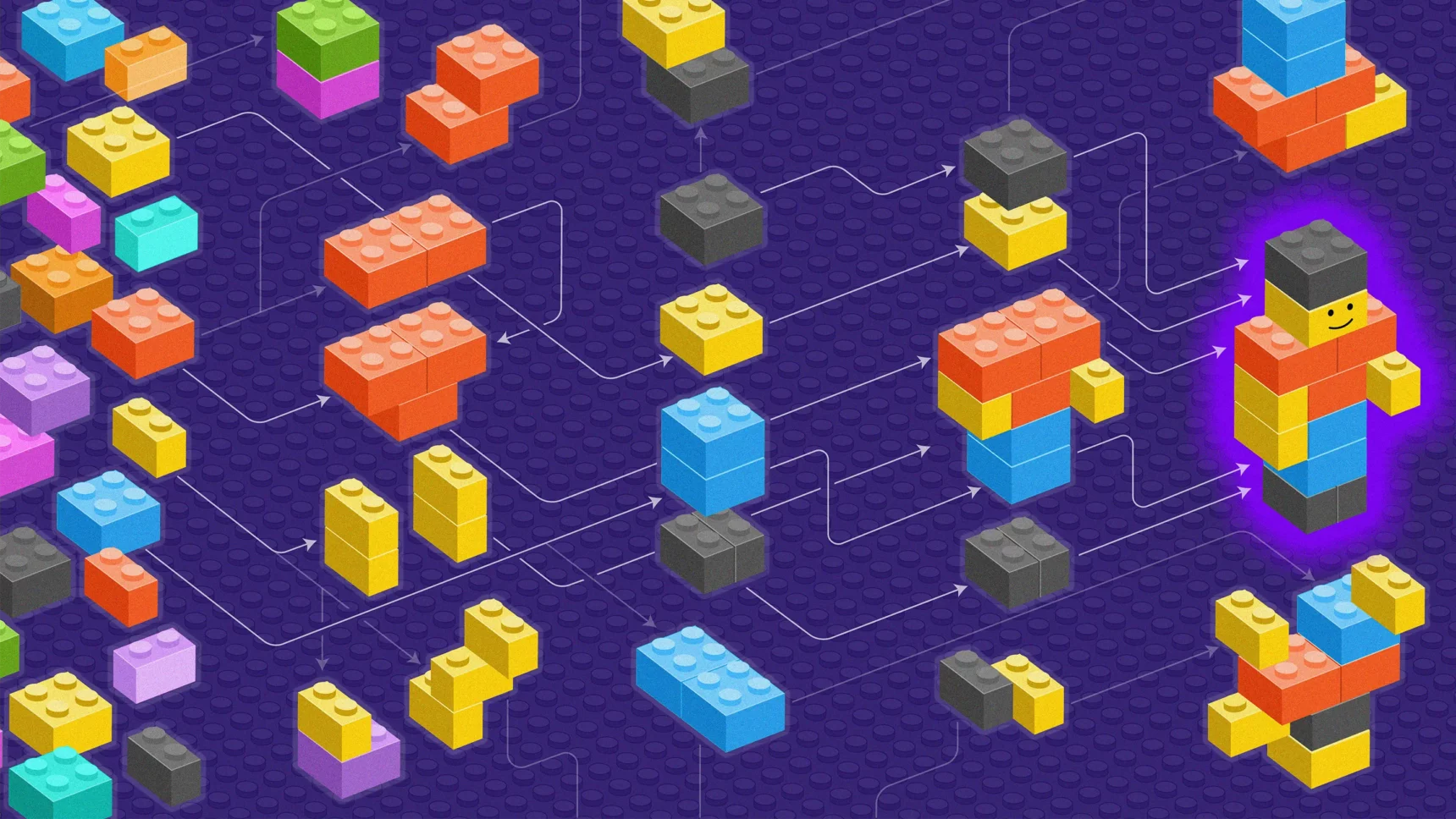A Mutation Turned Ants Into Parasites in One Generation
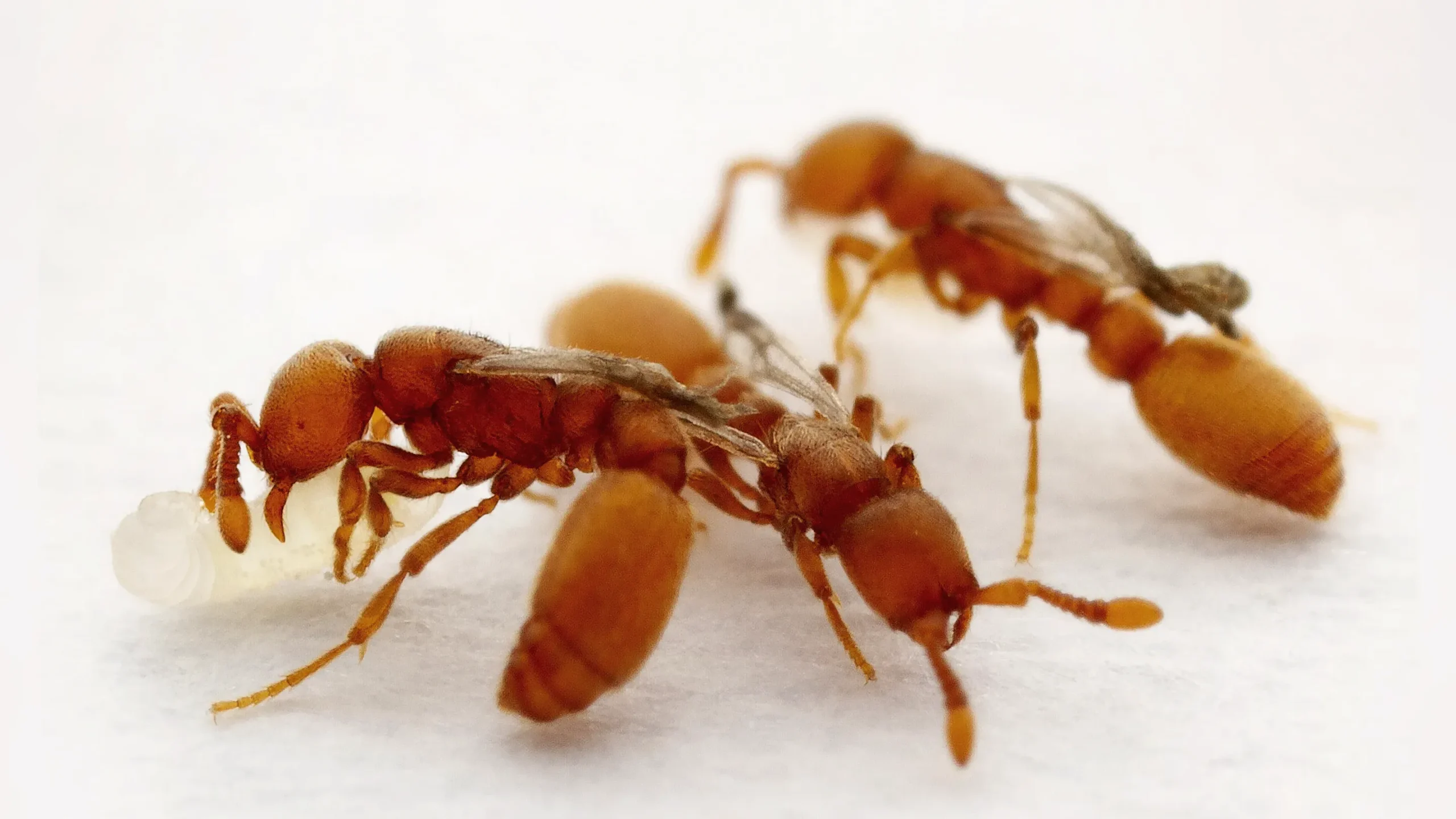
Because of their wing buds, these members of the clonal raider ant species resemble queens, but they are instead “inquiline” social parasites. They lay eggs that workers in the colony care for like their own offspring.
Daniel Kronauer
Introduction
When the researcher Daniel Kronauer was still a postdoc in 2008, he traveled to Okinawa, Japan, for wild specimens of clonal raider ants (the species Ooceraea biroi). In the first colony he collected, he noticed two ants with a strange appearance. They were small like workers, but they also sported small wing buds, which was striking because usually only ant queens develop wings. What made this even stranger was that clonal raider ants don’t even have queens: In keeping with their name, these ants reproduce asexually, so all the ants in a colony are nearly perfect genetic clones.
Kronauer was intrigued by the miniature queens because they seemed so different from the other clonal raider ants even though he believed them to be the same species. But answers to his questions weren’t forthcoming, so he took some specimens, shot some photos for records and then moved on with his work.
A few years later, Kronauer established a lab at Rockefeller University and set up a colony of clonal raider ants for study. One day, his then-doctoral student Buck Trible found a few more of the odd miniature queens in that colony and decided to characterize them.
Trible found that the wings weren’t the ants’ only unusual characteristic. The strange ants also showed different social behaviors, had larger ovaries and laid twice as many eggs. Using genetic tools, he traced all of these changes to a 2.25-million-base-pair-long stretch of DNA. In the ordinary ants, the DNA on each of the two copies of their chromosome 13 was different. But in the miniature-queen ants, the two copies were identical.
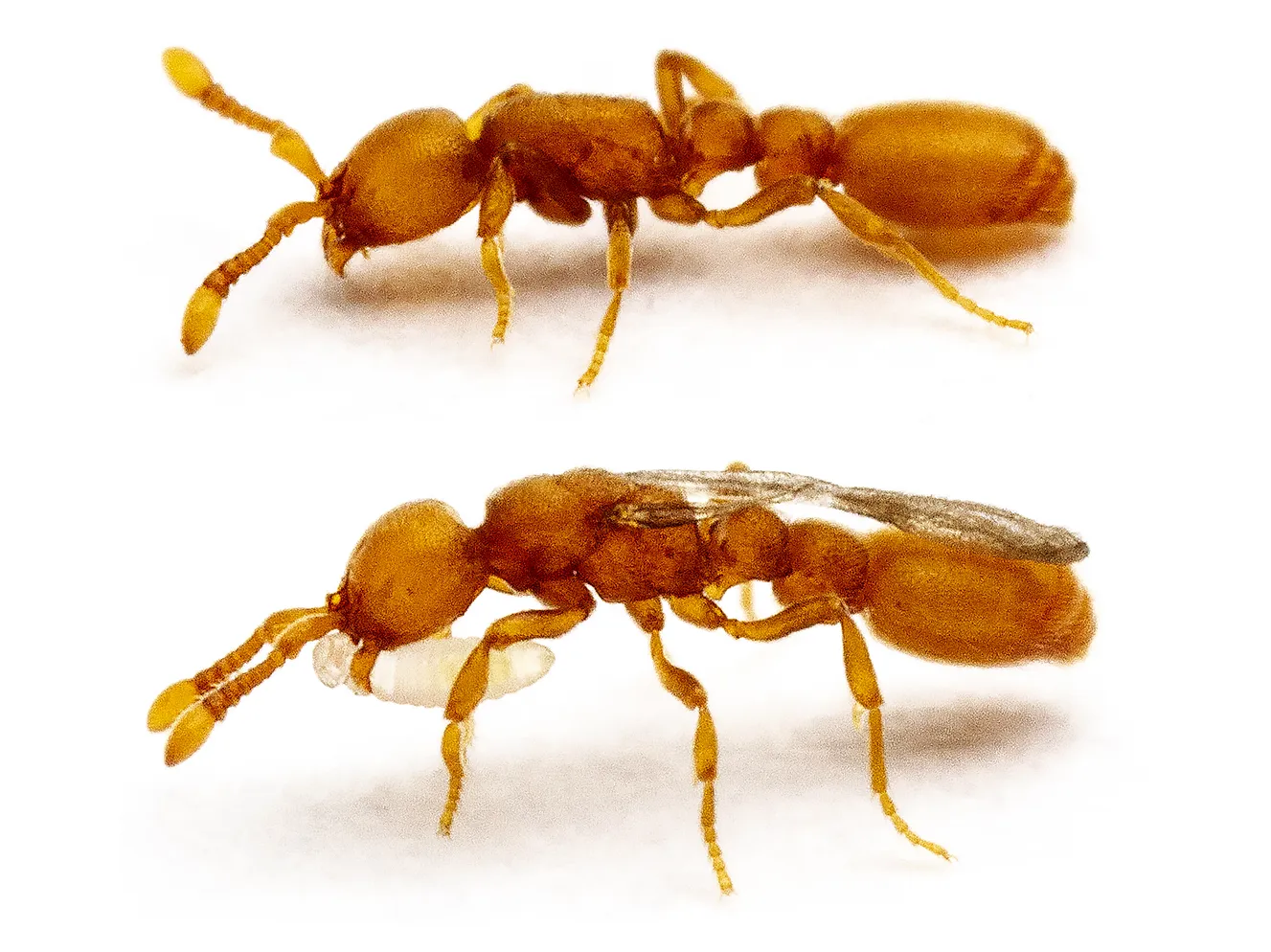
A mutant “inquiline” social parasite (at bottom) is roughly the size of a worker (at top) in a clonal raider ant colony. However, the inquiline’s wing buds and its ability to lay more eggs are more typical of the queens of other ant species.
Daniel Kronauer
As Trible, Kronauer and their colleagues reported in March in Current Biology, all of the characteristics of the odd ants — the wings, the social behaviors and the reproductive traits — were caused by what geneticists call a supergene, a collection of genes that are inherited as a unit and are highly resistant to being broken up. At some point in their evolution, the ants had acquired a second copy of that supergene, and that chromosomal change had transformed their bodies and behaviors. The findings suggested a new mechanism for how complex combinations of body parts and behaviors can sometimes surface all at once in evolution: through a mutation that duplicates a supergene, toggling on entire suites of traits like strings of lights controlled by a light switch.
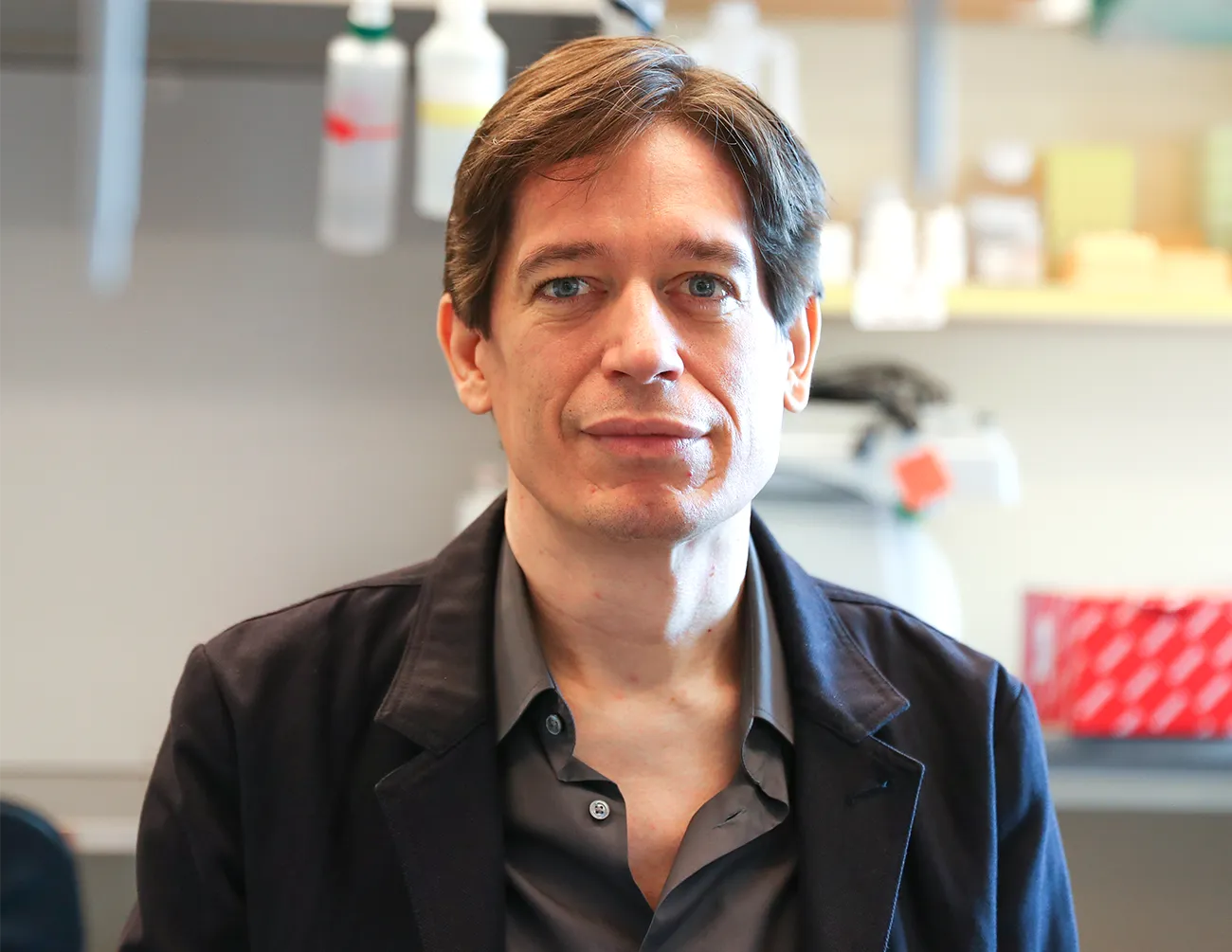
Daniel Kronauer of Rockefeller University, who studies the evolution of insect societies, noticed the miniature queenlike mutants in a colony of clonal raider ants during a trip to Okinawa.
Bennett Raglin/AP Images for HHMI
Ant researchers are excited by the work, and not just because it seems to solve a decades-old mystery about how at least one form of social parasitism evolves in the insects. The supergene discoveries may also help them pin down long-sought features in ants’ genetic architecture that make their colonies develop as hierarchical castes of queens and workers.
More broadly, the new study also offers insights into a fundamental evolutionary question about how different the individuals in a single species can be.
“The most exciting thing about this study is just how many future directions it opens up,” said Jessica Purcell, an evolutionary geneticist at the University of California, Riverside who studies ant genomes.
A Paradox of Parasitism
Ants attract the attentions of researchers like Kronauer and Trible because most species have a social structure that is wedded to their biology. In a typical nest, a single large, reproductive queen ant presides over legions of smaller, nonreproductive female workers who are her daughters. The workers build a nest, gather food, repel invaders and care for the colony’s young, freeing the queen to just lay eggs.
Some ant species, however, depart from that plan by engaging in forms of social parasitism — that is, they exploit the social structure of another ant species. Slave-making ants, for example, steal larvae from other nests and chemically imprint them to become workers serving the slavers’ queen.
Many decades ago, researchers noticed that some ant species employ a more clandestine kind of parasitism. The parasites have lost their worker caste. To survive, their small queens infiltrate the colonies of other ant species and lay eggs there. The exploited host workers then do everything for them, from taking care of their brood to protecting and feeding them. Such a relationship between species is called obligate parasitism, because the parasites cannot survive on their own.
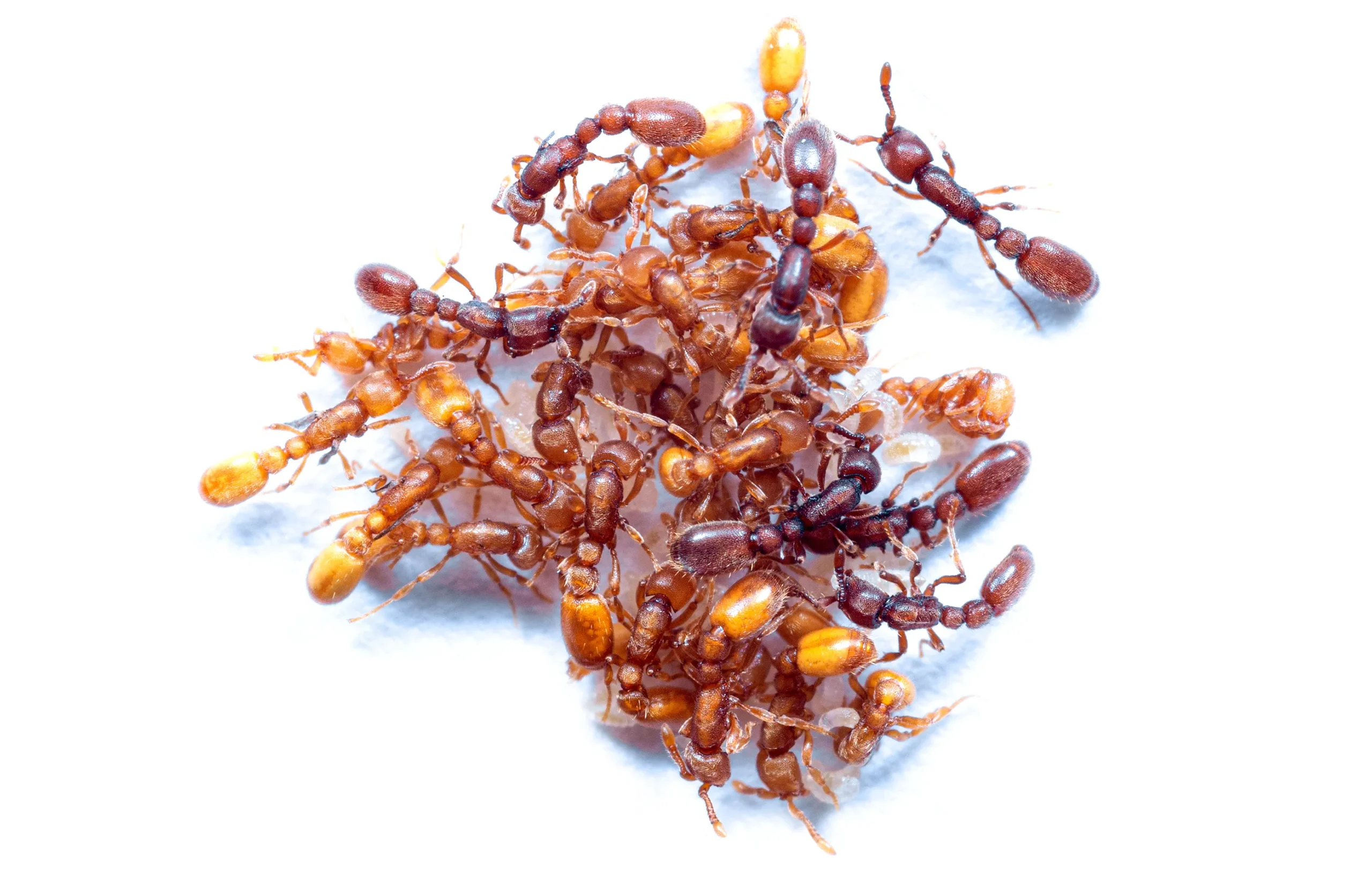
Because of their wing buds, the mutant ants stand out from the workers to human eyes. Yet they can blend into a clonal raider ant colony by disguising themselves with the scents of workers.
Daniel Kronauer
These workerless social parasites, sometimes called inquilines (from the Latin word for “tenants”), have a distinctive appearance that to human eyes easily sets them apart from their hosts. But their parasitic scheme succeeds because they have evolved ways to steal chemical odors from the host nest to camouflage themselves.
Genomic analyses have shown that ant inquiline species have independently evolved dozens of times, and nearly all of them parasitize a closely related species that looks and behaves as ants normally do. For evolutionary biologists, that posed a mystery: How could a new species of obligate social parasites evolve from its host species? If their ancestors had lived together in the same nest, they would have interbred too easily.
For many years, researchers hypothesized that the initial step had been reproductive isolation: that the early ancestors of the inquilines were normal ants that were reproductively isolated from their kin long enough to diverge genetically from them and become a new species. They could live on their own, but some of them eventually discovered the benefits of sneaking back into the nests of their ancestors for help. Their dependence on their hosts gradually increased, and they evolved from a state of optional or “facultative” parasitism to obligate parasitism.
The problem with that idea, Kronauer explained, is that nobody has ever observed in the wild what should be an essential, early step of the process: free-living, facultative social parasites living in isolation from their close relatives.
Trible and Kronauer’s new findings turn the previous assumptions on their head. Their alternative scenario focused on the pair of mismatched supergenes in the clonal raider ants. Sometime in history, one of those ants had experienced a mutation that replaced the supergene on one chromosome with a copy of the supergene from the other chromosome. The resulting mutant ant with two copies of the “parasitic” version of the supergene could have suddenly developed into a miniature queen that looked a lot like an inquiline.
The work showed that a single mutation in a supergene was sufficient to produce the full suite of changes observed in the obligate parasites, even before the ants were split by speciation.
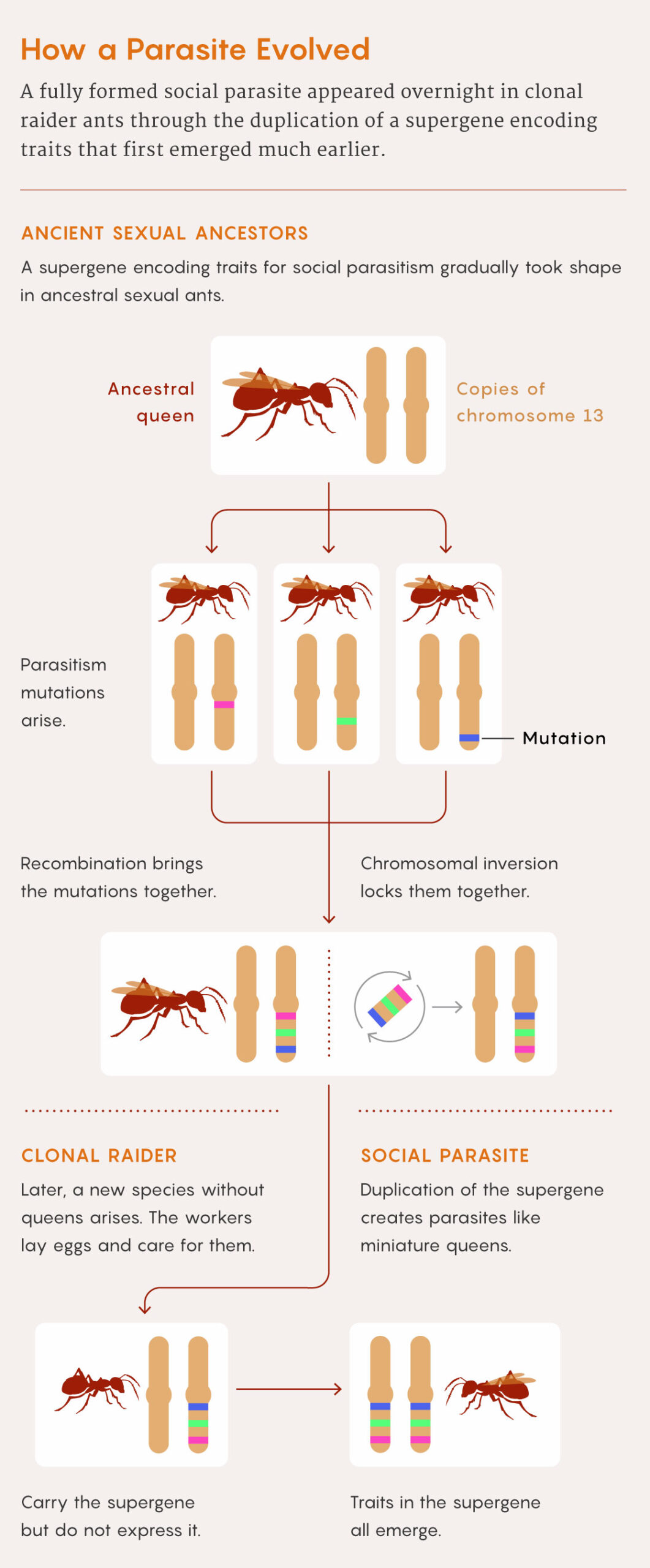
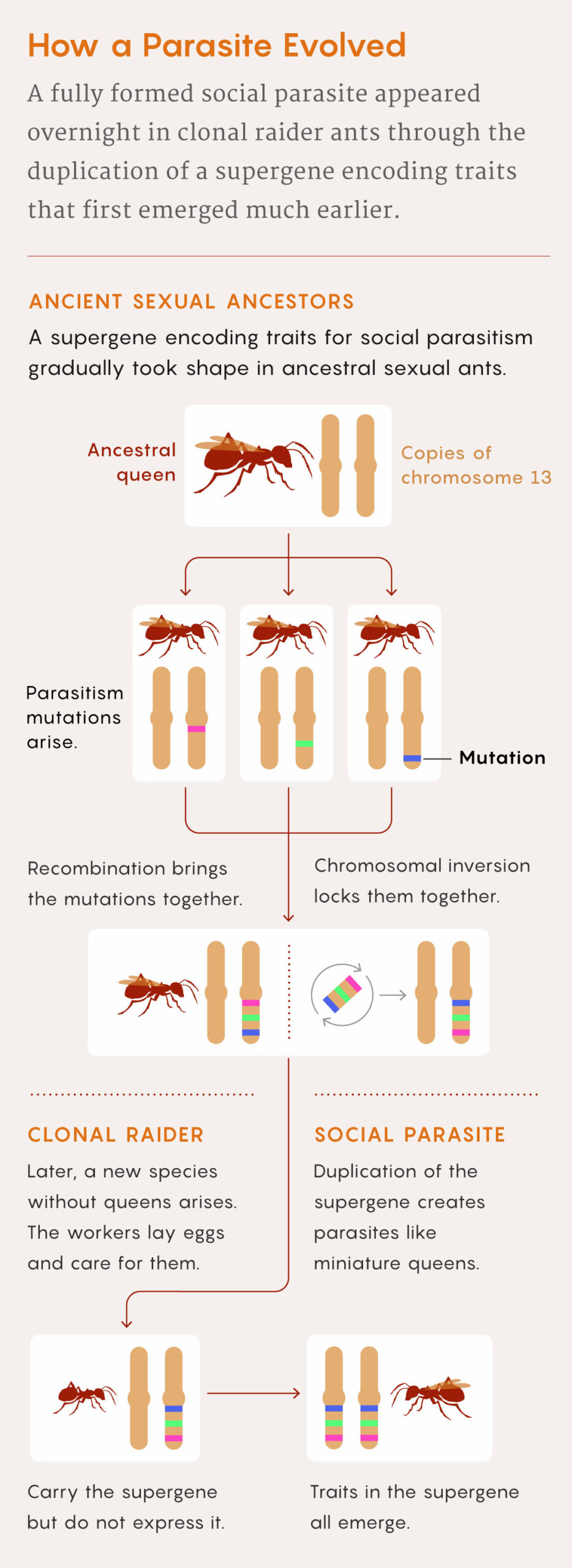
Merrill Sherman/Quanta Magazine
“You can go from free-living to obligately parasitic in one step, and you don’t need to take a number of gradual steps involving a reproductively isolated facultative intermediate population,” said Trible, who is now at Harvard University. “What we can be sure of is that a free-living parent had a daughter who was immediately an obligate parasite.”
He continued: “That is the scenario that had never been entertained by any of the classical evolutionary theorists, because that’s the scenario that was thought to be too big of a jump for you to take.”
The fact that a single mutation can shift all of these traits in a single step “really changes the way we think about the evolution of these weird, workerless social parasites,” Kronauer said.
The Strength of Supergenes
Little is known about the evolutionary history of the supergene on chromosome 13 that confers the social parasite phenotype. However, it is unlikely to have evolved in a clonal species like the raider ants. “The clonal ants would have been the last place to look for supergenes,” said Michel Chapuisat, who studies ant supergenes at the University of Lausanne in Switzerland.
The reason is that all the ants in a clonal species are genetically identical: Random mutations aside, their genomes pass unchanged from parent to child. Something more complicated, however, happens in sexually reproductive species.
In the cells that produce eggs and sperm, the maternal and paternal copies of the chromosomes line up and swap corresponding segments of DNA. This process of “recombination” allows sets of inherited traits to be reshuffled randomly; without it, genes would be locked into the maternal or paternal lineages forever.
Because of recombination, genes for various parasitic behaviors could have been randomly brought together on chromosome 13. Natural selection would then have strongly favored the union of those alleles that worked well together. “If you have a parasite-determining gene, you can gradually put a bunch of other genes next to it that make [the ant] better and better at being a parasite,” Trible said.
Recombination might have eventually separated those genes again, but a fateful genetic accident intervened. Sometimes when chromosomes are being repaired after damage, a piece of DNA gets reinserted in an inverted orientation. Because inverted DNA can’t line up with its chromosomal counterpart, it can’t recombine, so any genes in the DNA are permanently locked together as a new heritable unit — a supergene.
That may be what happened on chromosome 13: An inversion in that 2.25-million-base-pair stretch of DNA could have locked together the traits for social parasitism as a supergene, which natural selection then maintained. Purcell noted that a lot of research surrounds other ways that a supergene like this one could have emerged, but “there’s such a strong benefit of having alleles that work well together, brought together into a region with low recombination,” she said.
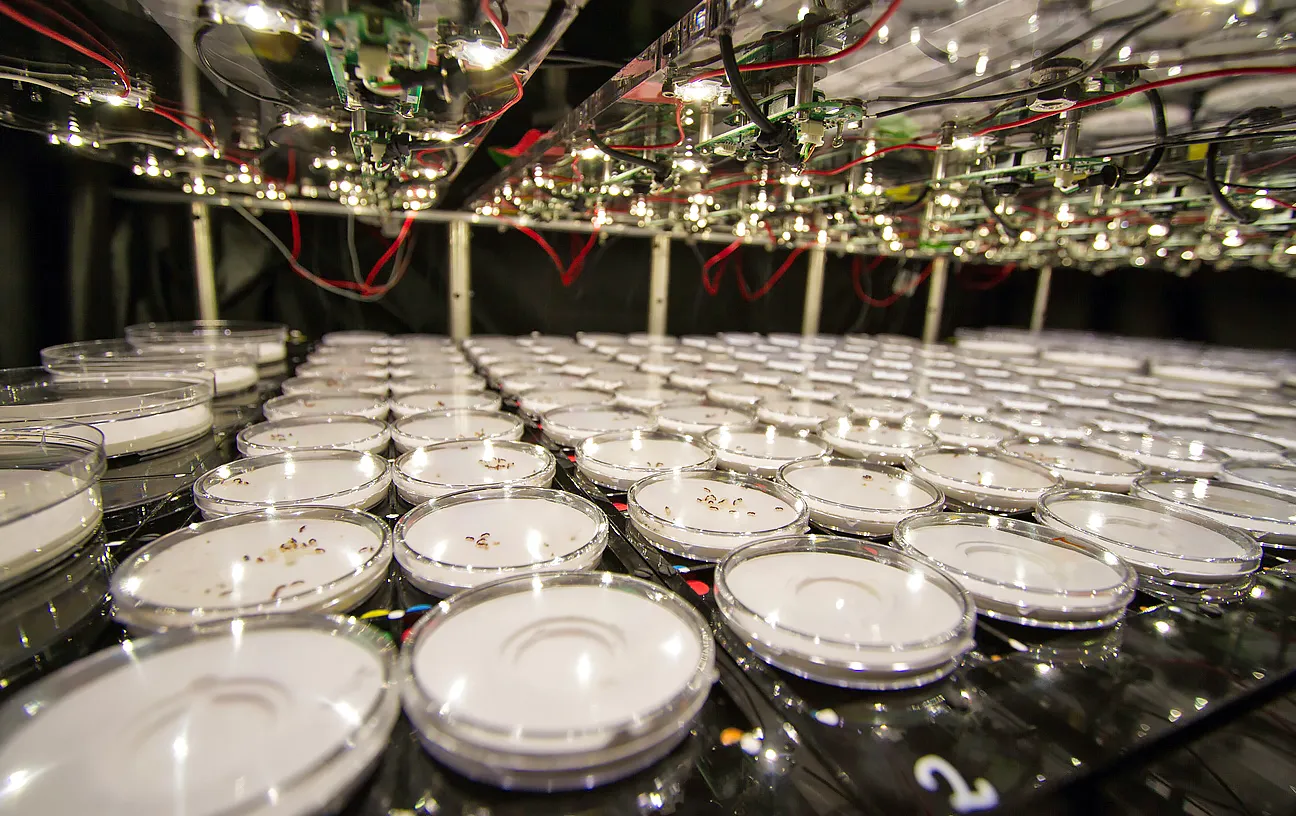
In Kronauer’s laboratory at Rockefeller University, clonal raider ants are maintained in a facility that allows the behaviors of hundreds of ants to be monitored at once.
Daniel Kronauer
Chapuisat thinks it’s likely that the supergene for all the observed parasitic traits evolved over a long time in a sexual ancestor of the clonal raider ants. The parasitism would have manifested in the ants that carried two copies of the supergene, and the ants with one or no copies would have been their hosts. When the raider ants became clonal and heterozygous, with just one copy of the supergene, the parasitic behavior disappeared — but the supergene persisted. And when a mutation eventually created new homozygous clonal raiders, the dormant supergene traits were reactivated and the miniature queenlike mutants appeared overnight.
Chromosome Rearrangement and Evolution
This ant supergene is far from an isolated example; if anything, it may illustrate a more general and still underappreciated way in which many complex traits evolve.
“There are more and more studies that show us that genome rearrangements can have a fundamental influence on behavior and on social organization of species,” said Christian Rabeling, an entomologist at the University of Hohenheim in Stuttgart, Germany, who studies how social parasitism evolved in ants.
In the 30-million-year-old, sexually reproducing genus of Formica ants, for example, there are at least four lineages in which a shared supergene determines whether their colony will have one queen or many. Other groups of ants have supergenes that they evolved independently, controlling suites of behavioral and morphological traits important to their way of life, Purcell said.
All of these supergenes could be what Trible and other researchers now call “social chromosomes.” Just as the X and Y sex chromosomes in humans determine sex, the supergenes in the ants determine the social organization of colonies. It’s not a glib comparison for Trible. Supergenes and sex chromosomes both bundle up genes that then are always inherited together and collectively confer sets of traits. Just as some sex-linked traits are advantageous for males or females but not both, the parasitic supergenes can be advantageous for the homozygous inquilines but not the heterozygous hosts.
“For some reason, population geneticists have set aside sex chromosomes like a separate form of evolution,” Trible said. Although it’s still uncertain how common the social chromosomes are, “what [they] are telling us is that supergenes are all over the place, and sex chromosomes are a special case of a supergene.”
Which exact genes and control elements are bundled up within the supergene of the clonal raider ants is still unknown. But dissecting that supergene and others in different ant species may reveal something about the evolution and development of castes in ant colonies. When an ant larva is developing, environmental cues determine whether it will become a queen or a worker, a decision that dictates the larva’s behavior, its body size, the development of its wings and ovaries, and its ability to lay eggs. Those traits are so strongly associated that researchers have found that experimentally shifting one usually pulls the others along with it. Trible and Kronauer think that by learning how the parasitism supergene altered the correlation between body size and the other queen-associated traits, researchers may be able to uncover the genetic mechanisms for normal caste development.
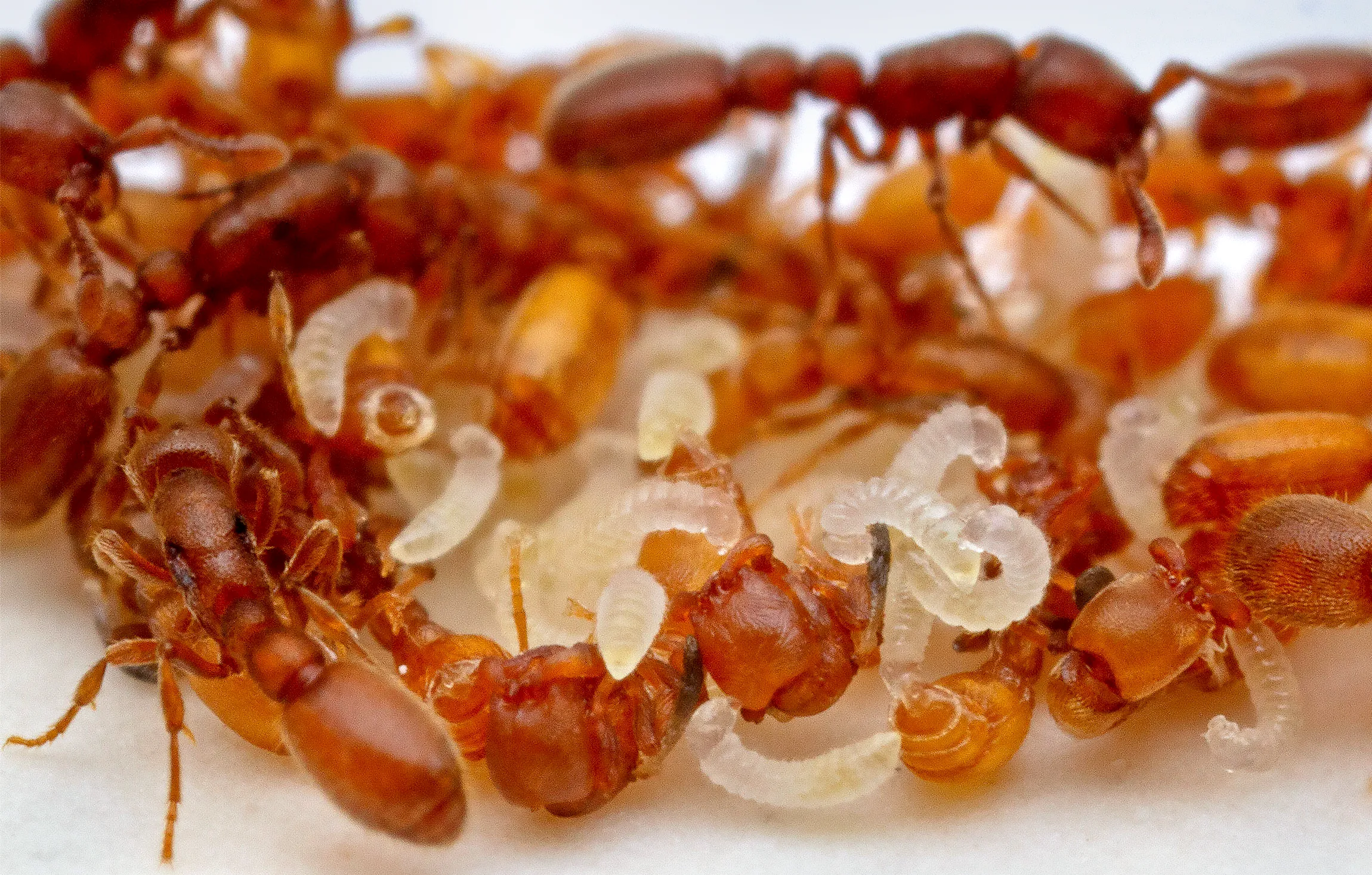
The mutants are classified as social parasites because after they lay their eggs in a nest, they leave all the care and feeding of their offspring to the workers.
Daniel Kronauer
Speciation, Evolution and Parasitism
Trible and Kronauer’s work also raises other questions about evolution and development, including how a supergene mutation relates to speciation. In the Formica ants, the single-queen and multi-queen colonies don’t seem to be splitting into independent lineages. Both forms of the supergene seem to be comfortably maintained as a “polymorphism” within a single species.
For Chapuisat, the question is whether the queenlike mutants are a “cheater lineage” behaving like a parasite within the clonal raider ant species. “Or is it on its way to become a separate species?” he asked.
How exactly a speciation event could happen after the parasitic phenotype arises is a mystery, but this kind of supergene mutation provides a plausible mechanism for rapid speciation through social parasitism, Purcell said. Both she and Chapuisat warned, however, that all these questions and speculations are complicated by the slipperiness of defining what a species is in a clonal organism like these ants.
To demonstrate that a supergene mutation actually is the mechanism by which social parasite species evolve, Rabeling suggests that it will be important to see if the inversions on chromosomes, which are structural hallmarks of supergenes, are present in many host-parasite pairs. Do the dozens of other inquiline ant species have similar supergene mutations?
Rabeling believes there may be other mechanisms, such as hybridization, that could also create the supergene with this constellation of traits. “I would expect that there is not only one mechanism for how social parasitism evolves, but it is probably many different mechanisms,” he said. “And the more empirical systems we study, the more mechanisms for the origin of social parasitism we would probably find.”



